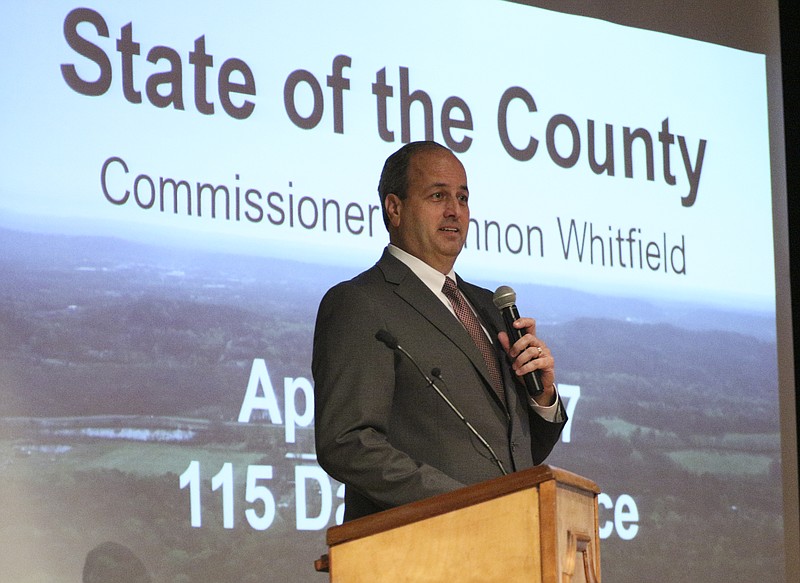Walker County emergency services will be getting where they need to be faster thanks to a few changes coming through for the department.
During his State of the County Address in April, Commissioner Shannon Whitfield spoke about the need to improve emergency response times in the north end of the county.
In a followup interview, recently hired Fire Chief Blake Hodge said response times to areas such as Rock Spring could be as long as 15 minutes, considering how far away the closest fully staffed station is, and that response times from the closer volunteer stations are typically slower because the volunteer firefighters are often at their paid jobs when they're called in.
The maximum recommended response time to a fire is around four minutes for the first engine to arrive on the scene, according to the National Fire Protection Agency.
In order to fix the local response time issue, the volunteer station in Flintstone is being remodeled to include living quarters so it can house full-time firefighters 24 hours a day. By having the Flintstone station fully staffed, response times should drop to around eight minutes, which is typical of other areas in the county, Hodge said.
The updated station will not have any newly hired firefighters. Instead, firefighters will be moved from other stations to the one in Flintstone to staff it.
"If we could afford the funding, we'd do that, but that's not a reality for us right now," said Hodge. "We're taking all our current resources and evaluating them to see how they can better serve our citizens."
Hodge estimates the new station will be ready the first week of July.
In addition, a change in the county's fleet of vehicles for emergency services is saving time and money. The county emergency department is repurposing "brush trucks" as quick-response vehicles for medical calls. During the State of the County, Whitfield said the quick-response vehicles, or QRVs, had responded to 284 of the 308 calls the county had received up to that point this year. There was no cost to the county to repurpose the vehicles, and the trucks were previously being unused by the county, he said.
Hodge confirmed those numbers, and said his department has been using the QRVs, which are currently housed in four full-time stations, for about 90 percent of calls. They are equipped with first aid equipment and tools to better respond to the non-fire related calls the department gets.
"We're a geographically challenged county and it's hard for us to keep the big trucks from wearing out if they're responding to every call," said Hodge.
The department still sends its full-size engines out to all fire calls, he noted.
Catoosa looks to diversify emergency response fleet
Money set aside during the 2009 and 2014 SPLOST cycle could mean improvements for Catoosa’s fire and rescue services in the coming months. At the county commission’s May 16 meeting, County Fire Chief Randy Camp presented a proposal requesting $2.7 million to update his department’s fleet of vehicles.During his presentation, he said he wants his department to maintain a fleet of 30 vehicles, but to diversify them and have them serve multiple functions, something he said is currently not an option.First on his proposal was cutting the number of fire engines from 12 to six and transitioning the oldest engines out of service. The oldest fire engine still in use in the county is a model from 1975, and there are several fire engines and tanker trucks from the late 1980s and early 1990s, he said.The old fire engines don’t meet current safety standards, added Camp.“There’s a bit of risk to using the older vehicles,” he said during a followup interview. “The new models have disc brakes all around, meaning they stop faster. They also have software that brakes automatically if it senses [the vehicle] could flip. Roll cages built into them will keep our firefighters safe, too.”Then, there’s the issue of the tanker trucks. The trucks are used to haul thousands of gallons of water to fires not close enough to a fire hydrant, such as car fires on the interstate, extremely rural parts of the county and homes that have an extended driveway too far from a hydrant. The current tankers the county uses can provide enough water to fight a fire for between three and four minutes. The tankers Camp wants to purchase can fight a fire for more than 12 minutes.“We’ve put together a committee to look into other departments and how they like their vehicles,” Camp said. “They went all the way up to Cumberland County in Tennessee to look at the pumper tanker they use. They’ve got to cover over 600 square miles and a large portion of Interstate 40. They told us how good the truck is on the interstate.”In addition, Camp wants to look into quick-response vehicles similar to the ones Walker County is now using. Just like its neighbor, much of the department’s calls are medical in nature, and sending a full-size fire engine out to each one reduces their lifespan considerably.“In my experience in Atlanta, trucks would only last us five to eight years of service since they took them everywhere,” Camp said. “The QRVs are better on fuel and they can respond to these calls a lot quicker. The engines only get about 4 miles to the gallon.”Camp said he believes diversifying the county’s emergency response vehicle fleet will save the county money long-term.The county commissioners approved the measure during the meeting. Camp said last Tuesday that the bidding process hadn’t begun just yet, as his department was still researching exactly what vehicles and specifications will be needed.
